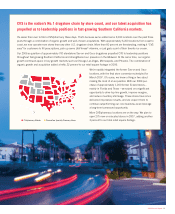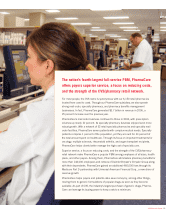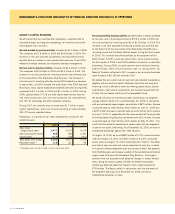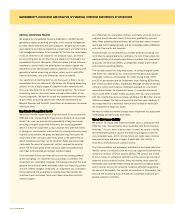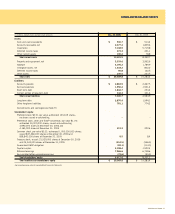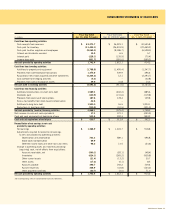CVS 2006 Annual Report Download - page 26
Download and view the complete annual report
Please find page 26 of the 2006 CVS annual report below. You can navigate through the pages in the report by either clicking on the pages listed below, or by using the keyword search tool below to find specific information within the annual report.
MANAGEMENT’S DISCUSSION AND ANALYSIS OF FINANCIAL CONDITION AND RESULTS OF OPERATIONS
2006 Annual Report 23
In anticipation of the execution of the accelerated share repurchase
upon consummation of the proposed merger with Caremark, we expect
to enter into a $1.25 billion, five-year unsecured back-up credit facility,
in addition to a facility which will act as a bridge facility, with a value
of $5.0 billion. The bridge facility is expected to terminate upon the
placement of longer-term financing.
Our credit facilities and unsecured senior notes contain customary
restrictive financial and operating covenants. These covenants do not
include a requirement for the acceleration of our debt maturities in
the event of a downgrade in our credit rating. We do not believe that the
restrictions contained in these covenants materially affect our financial
or operating flexibility.
Our liquidity is based, in part, on maintaining investment-grade debt
ratings. As of December 30, 2006, our long-term debt was rated “Baa2”
by Moody’s and “BBB+” by Standard & Poor’s, and our commercial paper
program was rated “P-2” by Moody’s and “A-2” by Standard & Poor’s,
each on positive outlook. On February 13, 2007, Moody’s placed our
long-term debt and commercial paper program on stable outlook, while
Standard and Poor’s changed its outlook to developing. In assessing our
credit strength, we believe that both Moody’s and Standard & Poor’s
considered, among other things, our capital structure and financial policies
as well as our consolidated balance sheet, our acquisition of the Standalone
Drug Business, the entry into a definitive merger agreement with Caremark
and other financial information. Although we currently believe our long-term
debt ratings will remain investment grade, we cannot guarantee the
future actions of Moody’s and Standard & Poor’s. Our debt ratings have
a direct impact on our future borrowing costs, access to capital markets
and new store operating lease costs.
OFF-BALANCE SHEET ARRANGEMENTS
In connection with executing operating leases, we provide a guarantee
of the lease payments. We finance a portion of our new store development
through sale-leaseback transactions, which involve selling stores to
unrelated parties and then leasing the stores back under leases that
qualify and are accounted for as operating leases. We do not have any
retained or contingent interests in the stores, nor do we provide any
guarantees, other than a guarantee of the lease payments, in connection
with the transactions. In accordance with generally accepted accounting
principles, our operating leases are not reflected in our consolidated
balance sheet.
Between 1991 and 1997, we sold or spun off a number of subsidiaries,
including Bob’s Stores, Linens ‘n Things, Marshalls, Kay-Bee Toys, Wilsons,
This End Up and Footstar. In many cases, when a former subsidiary leased
a store, we provided a guarantee of the store’s lease obligations. When
the subsidiaries were disposed of, the guarantees remained in place,
although each initial purchaser agreed to indemnify us for any lease
obligations we were required to satisfy. If any of the purchasers were to
become insolvent and failed to make the required payments under a
store lease, we could be required to satisfy these obligations. Assuming
that each respective purchaser became insolvent, and we were required
to assume all of these lease obligations, we estimate that we could settle
the obligations for approximately $350 to $400 million as of December 30,
2006. As of December 30, 2006, we guaranteed approximately 240
such store leases, with the maximum remaining lease term extending
through 2022.
We currently believe that the ultimate disposition of any of the lease
guarantees will not have a material adverse effect on our consolidated
financial condition, results of operations or future cash flows.
Following is a summary of our significant contractual obligations as of December 30, 2006:
Payments Due by Period
Within 1–3 3–5 After 5
In millions Total 1 Year Years Years Years
Operating leases $ 19,875.0 $ 1,445.7 $ 2,740.5 $ 2,674.0 $ 13,014.8
Long-term debt 3,093.8 342.1 696.6 802.7 1,252.4
Purchase obligations 0.4 0.4 – – –
Other long-term liabilities reflected
in our consolidated balance sheet 381.6 55.3 236.1 43.2 47.0
Capital lease obligations 120.9 2.3 5.4 6.8 106.4
$ 23,471.7 $ 1,845.8 $ 3,678.6 $ 3,526.7 $ 14,420.6


